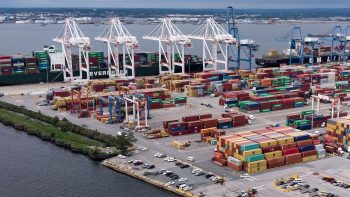
How much will the Baltimore bridge reconstruction cost?

When the Francis Scott Key Bridge was struck by a cargo ship last week, it brought down an economic engine along with the bridge.
The Baltimore bridge supported more than 150,000 jobs and served as a crucial link in supply chains. Rebuilding it could cost billions of dollars and take up to five years.
How much will rebuilding cost?
Using New York’s Gov. Mario M. Cuomo Bridge — also known as the Tappan Zee Bridge — as a comparison, rebuilding will cost between $1 billion and $5 billion, said Justin Marlowe, a research professor at the University of Chicago’s Harris School of Public Policy.
The Cuomo Bridge, which crosses the Hudson River, cost about $4 billion to build. The Baltimore bridge is a little more than half that size.
“We can assume a full reconstruction of the Key Bridge will be at least half that $4 billion, and probably more than half given recent cost inflation. That would put the Key Bridge at around $3 billion,” Marlowe said.
Materials needed to build bridges have become more expensive, Marlowe explained, especially steel and concrete. If the city of Baltimore wants the reconstructed bridge to be more resilient than the original, that may push the cost to as high as $5 billion.
“They might have the option for a less costly reconstruction depending on the ultimate scope of the damage. That could be as low as $1 billion, although that’s unlikely,” Marlowe said.
Labor costs will make up a significant chunk of the final price tag. Specialized laborers, such as underwater welders, may be needed for more sophisticated designs, Marlowe said.
“It’s gonna be a very expensive, very high profile, potentially very long, very time-consuming process for the state of Maryland, the port, the city of Baltimore and everyone else,” Marlowe said.
Joseph L. Schofer, a professor emeritus of civil and environmental engineering at Northwestern University, gave a similar estimate for rebuilding — between $2 billion and $5 billion — based on the cost of other bridges, including the Cuomo Bridge, and adjusting for inflation.
The Cuomo Bridge is a cable-stayed, twin-span bridge, Schofer said, that is more resilient than Baltimore’s steel-truss bridge. The Baltimore bridge had an efficient design, but “everything was tied together,” meaning if you lose a key structural component, you lose the whole bridge.
Another advantage of a twin-span bridge is extra capacity, because people “tend not to be very good” at estimating future demand, Schofer said.
He estimates that the bridge could take three to five years to rebuild, leaning on the short side since the public’s attention is on the bridge. Two to three years “would be optimistic.”
“Harbor clearance is moving quickly, that’s a good sign. But to rebuild, there are many steps,” he said.
Who will pay to rebuild the bridge?
Last week, President Joe Biden said the federal government will pay for the entire reconstruction.
“If that happens, that will be a major shift in the way that we pay for infrastructure in this country. Roughly 75% of infrastructure that exists at the state and local level is paid for with state and local dollars,” Marlowe said.
The Biden administration has already approved $60 million of federal emergency funds to help rebuild the bridge. But some members of Congress have balked at the prospect of footing the whole bill. In an appearance on Fox Business, Rep. Dan Meuser, a Republican from Pennsylvania, said it was “outrageous” for Biden to say that federal funds would entirely pay for it.
There’s a good chance the government won’t pay the full cost, Marlowe said, but it may help with more costs than it typically would. He expects that the state of Maryland, the port, the city and county will also help pay for the remainder of the costs.
Marlowe said like most states, Maryland has a rainy-day fund it can tap into.
“The state of Maryland is already looking at distributing emergency dollars to different companies that use the port, to some of the shippers and others who can’t do business,” he said. “If those shipping companies in particular decide to take their business elsewhere by going to other ports, Baltimore’s very concerned that they won’t come back.”
In an appearance on MSNBC, Treasury Secretary Janet Yellen said money from the 2021 Bipartisan Infrastructure Law “could potentially be helpful,” while some insurance money is expected to be used.
“There’ll be insurance payments in part to cover this, but we don’t want to allow worrying about where the financing is coming to hold up reconstruction,” Yellen said.
While some in Congress have expressed concern about using taxpayer dollars for the bridge reconstruction, Marlowe said Americans benefit economically from robust infrastructure — especially port infrastructure.
“If you have ports that can more efficiently move cargo, that can operate safer, that can operate cleaner and greener — all of those things benefit consumers in lots of different ways,” Marlowe said. “If those things benefit consumers, then it ultimately benefits taxpayers because goods are getting to market faster, businesses can sell more stuff and generate more tax revenue. So port investments do tend to have pretty clear economic benefits.”
There’s a lot happening in the world. Through it all, Marketplace is here for you.
You rely on Marketplace to break down the world’s events and tell you how it affects you in a fact-based, approachable way. We rely on your financial support to keep making that possible.
Your donation today powers the independent journalism that you rely on. For just $5/month, you can help sustain Marketplace so we can keep reporting on the things that matter to you.


















